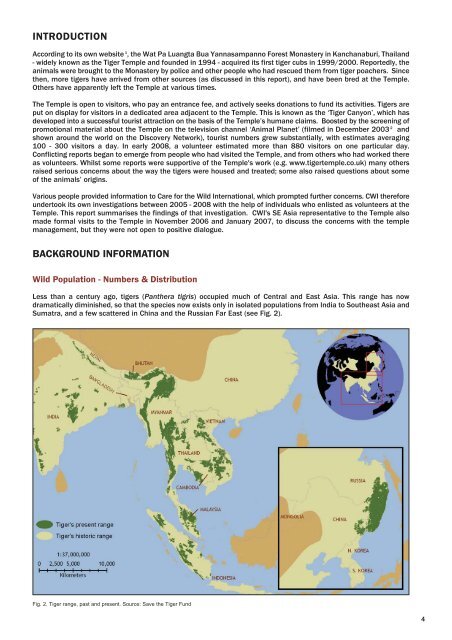EXPLOITING THE TIGER
EXPLOITING THE TIGER
EXPLOITING THE TIGER
You also want an ePaper? Increase the reach of your titles
YUMPU automatically turns print PDFs into web optimized ePapers that Google loves.
INTRODUCTION<br />
According to its own website 1 , the Wat Pa Luangta Bua Yannasampanno Forest Monastery in Kanchanaburi, Thailand<br />
- widely known as the Tiger Temple and founded in 1994 - acquired its first tiger cubs in 1999/2000. Reportedly, the<br />
animals were brought to the Monastery by police and other people who had rescued them from tiger poachers. Since<br />
then, more tigers have arrived from other sources (as discussed in this report), and have been bred at the Temple.<br />
Others have apparently left the Temple at various times.<br />
The Temple is open to visitors, who pay an entrance fee, and actively seeks donations to fund its activities. Tigers are<br />
put on display for visitors in a dedicated area adjacent to the Temple. This is known as the ‘Tiger Canyon’, which has<br />
developed into a successful tourist attraction on the basis of the Temple’s humane claims. Boosted by the screening of<br />
promotional material about the Temple on the television channel ‘Animal Planet’ (filmed in December 2003 2 and<br />
shown around the world on the Discovery Network), tourist numbers grew substantially, with estimates averaging<br />
100 - 300 visitors a day. In early 2008, a volunteer estimated more than 880 visitors on one particular day.<br />
Conflicting reports began to emerge from people who had visited the Temple, and from others who had worked there<br />
as volunteers. Whilst some reports were supportive of the Temple's work (e.g. www.tigertemple.co.uk) many others<br />
raised serious concerns about the way the tigers were housed and treated; some also raised questions about some<br />
of the animals’ origins.<br />
Various people provided information to Care for the Wild International, which prompted further concerns. CWI therefore<br />
undertook its own investigations between 2005 - 2008 with the help of individuals who enlisted as volunteers at the<br />
Temple. This report summarises the findings of that investigation. CWI's SE Asia representative to the Temple also<br />
made formal visits to the Temple in November 2006 and January 2007, to discuss the concerns with the temple<br />
management, but they were not open to positive dialogue.<br />
BACKGROUND INFORMATION<br />
Wild Population - Numbers & Distribution<br />
Less than a century ago, tigers (Panthera tigris) occupied much of Central and East Asia. This range has now<br />
dramatically diminished, so that the species now exists only in isolated populations from India to Southeast Asia and<br />
Sumatra, and a few scattered in China and the Russian Far East (see Fig. 2).<br />
Fig. 2. Tiger range, past and present. Source: Save the Tiger Fund<br />
4


